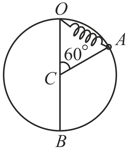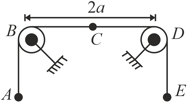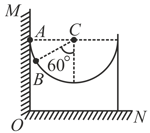The diagram shows a string of equally placed beads of mass , separated by distance . The beads are free to slide without friction on a thin wire. A constant force acts on the first bead initially at rest till it makes collision with the second bead. The second bead then collides with the third and so on. Suppose that all collisions are elastic.


Important Questions on Work, Energy and Power
Two blocks and each of mass , are connected by a massless spring of natural length and spring constant . The blocks are initially resting on a smooth horizontal floor with the spring at its natural length, as shown in diagram. A third identical block , also of mass , moves on the floor with a speed along the line joining and , and collides elastically with . Then:-

A particle of mass is free to slide on a smooth ring of radius fixed in a vertical plane. The particle is attached to one end of a spring whose other end is fixed the top point of the ring. Initially the particle is at rest at a point of the ring such that , being the centre of the ring. The natural length of the spring is also equal to . After the particle is released and slides down the ring the contact force between the particle & the ring becomes zero when it reaches the lowest position . Determine the force constant of the spring.

A light string whose mid point is passes through smooth rings and , which are fixed in a horizontal plane distance apart. To each of the points and is attached a mass . Initially is held at rest at (mid point ) and is then set free. What is the distance in meter when comes to instantaneous rest?
(Given )

For what minimum value of in for which the block of mass will just leave the contact with surface? (Given: )

A ball of mass is released from position, A inside a fixed wedge with a hemispherical cut of radius as shown in the figure. If the force exerted by the vertical wall on wedge, when the ball is in position , is then find the value of in . (neglect friction everywhere) (Take )

